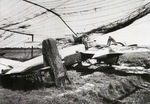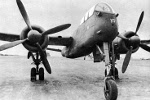He 219 Uhu
| Country | Germany |
| Manufacturer | Heinkel Flugzeugwerke |
| Primary Role | Night Fighter |
| Maiden Flight | 6 November 1942 |
Contributor: C. Peter Chen
ww2dbaseThe He 219 Uhu night fighters were developed as a response to a 1942 requirement for a sophisticated countermeasure against Allied bombers. Progress was initially delayed significantly due to the disagreements between Luftwaffe leader of the night fighters Josef Kammhuber and Ernst Heinkel, but they finally agreed upon a design in Nov 1942. In Jun 1943, three He 219s were delivered for combat testing; their first action took place on the night of 11-12 Jun, where the He 219 designated V9 single-handedly shot down five bombers. Over the next ten nights, the three test aircraft shot down a total of twenty British aircraft. Formal production soon began after the immensely successful combat testing. However, due to political stumbling blocks, production was interrupted for a time, and as a result only 288 were constructed during the war. He 219 pilots recalled the aircraft's power plant as underpowered, but they were very capable fighters nevertheless. The onboard SN-2 radar had a long effective range of 4km, therefore they were able to detect incoming hostile bombers far before their own locations were revealed.
ww2dbaseSource: Wikipedia.
Last Major Revision: Aug 2006
SPECIFICATIONS
HE 219A-7
| Machinery | Two Daimler-Benz DB 603E 12-cylinder inverted-V liquid-cooled engines rated at 1,750hp each |
| Armament | 4x20mm MG 151/20 cannons, 4xMK 108 30mm cannons |
| Crew | 2 |
| Span | 18.50 m |
| Length | 15.50 m |
| Height | 4.40 m |
| Wing Area | 44.40 m² |
| Weight, Maximum | 13,580 kg |
| Speed, Maximum | 669 km/h |
| Rate of Climb | 9.20 m/s |
| Service Ceiling | 9,300 m |
| Range, Normal | 1,540 km |
HE 219A-6
| Machinery | Two Daimler-Benz DB 603L 12-cylinder inverted-V liquid-cooled engines rated at 1,750hp each; GM-1 nitrous-oxide boost system |
| Armament | 2x30mm MK 108, 2x30mm MG 151/20, 2xMK 103 |
| Crew | 2 |
| Span | 18.50 m |
| Length | 15.50 m |
| Height | 4.40 m |
| Wing Area | 44.40 m² |
| Weight, Maximum | 13,580 kg |
| Speed, Maximum | 669 km/h |
| Rate of Climb | 9.20 m/s |
| Service Ceiling | 9,300 m |
| Range, Normal | 1,540 km |
Photographs
 |  |  |  |
Please consider supporting us on Patreon. Even $1 per month will go a long way! Thank you. Please help us spread the word: Stay updated with WW2DB: |
Visitor Submitted Comments
8 Jul 2010 12:55:18 PM
According to stats only 100 of the He 219 did reach the front until very late '44. More than 60 were 'lost' due to technical trouble (the A-0 should be evaluation serie... but was pushed into service) - there were problems, things any fighter had at early stages. 20 were lost due to enemy fire.
With those limited 100 planes and the corresponding losses... the pilots scored about 108 kills of RAF bombers, and shot down about 12 Mosquitos.
It was a night fighter with 'first-stage' trouble, but very promissing...
8 Jan 2017 04:23:14 PM
fascinating,found entry in a book my dad gave me back in the1980's,title had something about a falcon
All visitor submitted comments are opinions of those making the submissions and do not reflect views of WW2DB.
- » Race, Holocaust, and African-American WW2 Histories Removed from the US Naval Academy Library (7 Apr 2025)
- » US Government Plans to Purge WW2 Information (17 Mar 2025)
- » WW2DB's 20th Anniversary (29 Dec 2024)
- » See all news
- » 1,167 biographies
- » 337 events
- » 44,601 timeline entries
- » 1,243 ships
- » 350 aircraft models
- » 207 vehicle models
- » 376 weapon models
- » 123 historical documents
- » 261 facilities
- » 470 book reviews
- » 28,505 photos
- » 366 maps
General Douglas MacArthur at Leyte, 17 Oct 1944
Please consider supporting us on Patreon. Even $1 a month will go a long way. Thank you!
Or, please support us by purchasing some WW2DB merchandise at TeeSpring, Thank you!
12 Oct 2009 11:13:32 AM
The He 219 was an advanced night fighter the
aircraft was equipped with early designed ejection seats. Over 60 aircrew used the seats to escape from their aircraft.
One of the first pilots to use the ejection
seat was Otto Fries: taking fire from enemy
aircraft, one engine on fire and facing loss
of control, Fries ejected, thus saving his life.